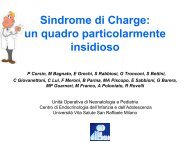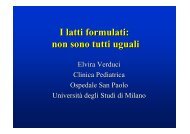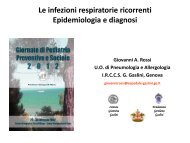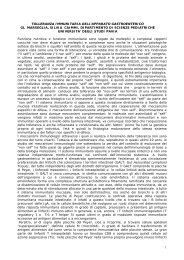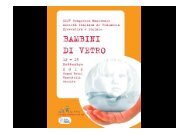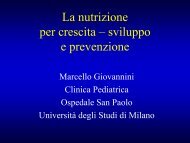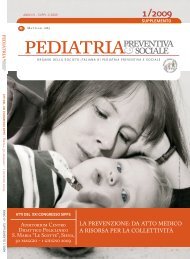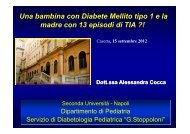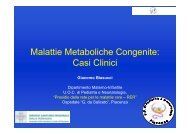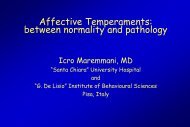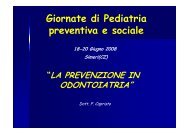T.Mazzei, A.Novelli pdf - Sipps
T.Mazzei, A.Novelli pdf - Sipps
T.Mazzei, A.Novelli pdf - Sipps
You also want an ePaper? Increase the reach of your titles
YUMPU automatically turns print PDFs into web optimized ePapers that Google loves.
Attualità in tema di farmaci equivalenti:<br />
Luci ed ombre<br />
Teresita <strong>Mazzei</strong> Andrea <strong>Novelli</strong><br />
Dipartimento di Farmacologia Preclinica e Clinica<br />
Università degli Studi di Firenze
DEFINIZIONE DI FARMACO<br />
GENERICO / EQUIVALENTE<br />
Un farmaco che ha la stessa composizione<br />
qualitativa e quantitativa di sostanze attive e la<br />
stessa forma farmaceutica del medicinale di<br />
riferimento nonché una bioequivalenza con il<br />
farmaco di riferimento dimostrata da studi<br />
appropriati di biodisponibilità<br />
art. 10, comma 5 DLvo n. 219/06;<br />
art. 10, comma 2 Direttiva europea 2001/83/CE<br />
e successive modificazioni<br />
Normativa italiana ed europea
FARMACO GENERICO / EQUIVALENTE<br />
• I vari sali, esteri, eteri, isomeri, miscele di isomeri, complessi<br />
o derivati di una sostanza attiva sono considerati la stessa<br />
sostanza attiva se non presentano differenze significative<br />
delle proprietà relative alla sicurezza e/o efficacia.<br />
• Le varie forme farmaceutiche orali a rilascio immediato sono<br />
considerate una stessa forma farmaceutica.<br />
• Gli eccipienti possono essere differenti<br />
art. 10, comma 5 DLvo n. 219/06;<br />
art. 10, comma 2 Direttiva europea 2001/83/CE<br />
e successive modificazioni.<br />
Normativa italiana ed europea
Farmaco Generico / Equivalente<br />
principio attivo:<br />
stessa quantità del<br />
principio attivo del brand<br />
Sali o esteri diversi<br />
eccipienti:<br />
stesse sostanze o diverse<br />
da quelle presenti nel<br />
brand<br />
Bioequivalenza: + 20%
Concentration<br />
Study Compound<br />
C max<br />
Pharmacokinetic Studies<br />
Key Measurements<br />
Reference Compound<br />
AUC<br />
• A difference of greater<br />
than 20% in C max or the<br />
AUC represents a<br />
significant difference<br />
between the study and<br />
reference compounds<br />
Tmax Time<br />
Approved Drug Products With Therapeutic Equivalence Evaluations. 23rd Tmax ed. 2003. FDA/CDER Web site.<br />
Available at: http://www.fda.gov/cder/ob/docs/preface/ecpreface.htm#Therapeutic Equivalence-Related Terms.<br />
Accessed September 29, 2003.
Pharmacokinetic<br />
Reference Range<br />
FDA and EMA Requirements for Bioequivalence<br />
125%<br />
100%<br />
80%<br />
Product A<br />
Bioequivalent<br />
Reference<br />
Drug<br />
Product B<br />
Not Bioequivalent<br />
• Product A is bioequivalent to the<br />
reference drug; its 90%<br />
confidence interval of the AUC<br />
falls within 80% to 125% of the<br />
reference drug<br />
• Product B is not bioequivalent to<br />
the reference drug; its 90%<br />
confidence interval of the AUC<br />
falls outside of 80% to 125% of<br />
the reference drug<br />
Approved Drug Products With Therapeutic Equivalence Evaluations. 23 rd ed. 2003. FDA/CDER Web site.<br />
Available at: http://www.fda.gov/cder/ob/docs/preface/ecpreface.htm#Therapeutic Equivalence-Related Terms.<br />
Accessed September 29, 2003.
Concentration<br />
Pharmacokinetic of changes<br />
Time
The Annals of Pharmacotherapy n 2009<br />
October, Volume 43
Blue Cross Blue Shield of Michigan Billboards
• Scadenze brevetti<br />
• Produttività RD<br />
• Evoluzione della Società<br />
– Sicurezza<br />
Scenari del farmaco 2010 - 2015<br />
• Evoluzione della Sanità<br />
– crisi finanziaria e maggiori costi<br />
• Scienza e Tecnologia
Lo sviluppo del mercato generici/biosimilari<br />
• Nel mondo il brand era il 70% del mercato nel 2005, il 64%<br />
nel 2010, sarà il 53% nel 2015. Nei paesi emergenti nel 2015<br />
per ogni $ in farmaci 80 centesimi saranno per un generico.<br />
• La maggior espansione degli equivalenti sarà in USA<br />
• Entro il 2015 la scadenza dei brevetti darà 98 miliardi di $ di<br />
risparmi (54 nel 2005-2010 nei Paesi sviluppati, 120 nel<br />
mondo).<br />
IMS "The Global Use of Medicines: Outlook Through 2015
Lo sviluppo del mercato (2)<br />
• Entro il 2015, la spesa farmaceutica globale<br />
arriverà a 1,1 trilioni di dollari (1.000 miliardi di<br />
miliardi), con un aumento annuale del 3-6%; un<br />
calo rispetto al 6,2% di crescita annuale del<br />
quinquennio precedente. Tra 5 anni la spesa per i<br />
biosimilari sarà > 2 miliardi di dollari all’anno (circa<br />
l’1% della spesa totale per farmaci biologici)<br />
Tra le aeree terapeutiche l’oncologia manterrà l’attuale ‘pole-position’ (> 5 - 8%)<br />
IMS "The Global Use of Medicines: Outlook Through 2015
Canada<br />
France<br />
Germany<br />
Italy<br />
Japan<br />
S Korea<br />
Spain<br />
UK<br />
US<br />
Generics will exceed 20% of spending in most<br />
developed markets<br />
Developed Markets Generic Share<br />
(Souce: IMS Market Prognosis, Apr 2011)<br />
The Global Use of Medicines: Outlook Through 2015<br />
Report by the IMS Institute for Healthcare Informatics<br />
• Increased generic spending in the next five years<br />
will be driven by generic competition in new<br />
molecules due to patent expiry<br />
• Additional generic share gains will come from<br />
increased incentives for the usage of generics in<br />
many markets<br />
• The U.S. will see the largest expansion of<br />
generics market spending, but the 7-8% gain will<br />
largely be from new generics as U.S.<br />
pharmacists already dispense generics, when<br />
available, 93% of the time<br />
• Japan will remain the developed market with the<br />
lowest generic share despite significant policy<br />
incentives to increase generic prescribing and<br />
dispensing<br />
• South Korea, with its well-developed domestic<br />
industry, will continue to spend the most on<br />
generics as a share of spending<br />
Chart notes<br />
Spending share in USS with variable exchange rates.<br />
Generic share of total pharmaceutical spending is calculated using<br />
IMS MIDAS market segmentation methodology. Generic segment<br />
includes branded generics and excludes OTC medicines
Generic antibiotics commercially available in Italy<br />
Ampicillin<br />
Amoxicillin +/- clavulanic acid<br />
Clarithromycin<br />
Clindamycin<br />
Amikacin Chloramphenicol<br />
Azithromycin Erythromycin<br />
Cefaclor Flucloxacillin<br />
Cefazolin Fosfomycin<br />
Cefonicid Gentamicin<br />
Cefotaxime Levofloxacin<br />
Ceftriaxone Norfloxacin<br />
Ceftazidime Piperacillin +/- tazobactam<br />
Cefuroxime Vancomycin<br />
Ciprofloxacin (Teicoplanin)<br />
Concia E et al., J Chemother, 2007, modified 2012
Comparative bioavailability of 875mg amoxicillin tablets in<br />
healthy human volunteers<br />
Baglie S, Rosalen PL, Franco LM, Ruenis AP, Baglie RC, Franco GC, Silva P, Groppo FC<br />
Pracicaba Dental School, State Univeristy of Campinas, Piracicaba, SP, Brazil<br />
Objective: To compare the bioavailability of amoxicillin 875mg tablets (EMS Sigma Pharma used as test<br />
formulation) and Amoxil BD 875mg tablets (GlaxoSmithKline used as reference formulation) in 26<br />
healthy volunteers.<br />
Material and methods: 26 healthy volunteers (13 males and 13 females) received each formulation in an<br />
open, 2x2 crossoover, randimized study with seven days of washout period between doses.<br />
Results: The mean values (± SD) were:<br />
Brand Generic<br />
AUC 0-12 (mg·h/l) 51.11 ± 18.9 55.42 ± 16.85<br />
C max (mg/l) 17.83 ± 5.86 18.59 ± 6.3<br />
t½ (h) 1.52 ± 1.31 1.49 ± 1.57<br />
t max (h) 2.02 ± 0.87 2.04 ± 0.75<br />
Confidence interval (90%) of amoxicillin<br />
means of AUC 0-12 h and Cmax ratios<br />
(generic/brand) were: 0.961 – 1.149 and<br />
0.914 - 1.142, respectively, agreeing with<br />
the bioequivalence criteria established by<br />
the Brazilian National Health Surveillance<br />
Agency<br />
Conclusion: BOTH FORMULATIONS WERE BIOEQUIVALENT BASED ON BOTH THE RATE AND EXTENT<br />
OF ABSORPTION<br />
Int J Clin Pharmacol Ther, 2005 Jul; 43(7): 350-4
Lack of pharmacokinetic bioequivalence<br />
between generic and branded amoxicillin<br />
formulations. A post-marketing clinical study<br />
on healthy volunteers<br />
Del Tacca et al.,<br />
BJCP, 2009; 68: 34–42
Mean amoxicillin concentration-time profiles in plasma<br />
following the administration of branded or generic<br />
amoxicillin formulations to 24 healthy volunteers<br />
Concentration (mg/l)<br />
Del Tacca M et al., Br J Clin Pharmacol, 2009<br />
Branded<br />
Generic A<br />
Generic B<br />
Time (h)
Studio comparativo di 65 prodotti generici di claritromicina<br />
Contenuto medio di principio attivo<br />
Prodotto brand<br />
Provenienza % contenuto dichiarato<br />
250 mg 500 mg<br />
Europa (2) 97,2 – 97,6 (1) 98,4<br />
America Latina (1) 99,6<br />
Generici<br />
Provenienza % contenuto dichiarato<br />
250 mg 500 mg<br />
Europa (9) 94,8 – 100,0 (12) 94,4 – 103,0<br />
America Latina (2) 95,2 – 103,2 (4) 94,6 – 102,0<br />
Asia, Africa, Pacifico (25) 94,8 – 107,6 (13) 94,2 – 101,0<br />
( ) numero dei prodotti<br />
Nightingale CH, Clin Drug Investig, 2005
Generic versus non-generic formulation of extended-release clarithromycin in<br />
patients with community-acquired respiratory tract infections: a prospective,<br />
randomized, comparative, investigator-blind, multicentre study<br />
Snyman JR, Schoeman HS, Grobusch MP, Henning M, Rabie W, Hira M, Parshotam K, Mithal Y, Singh S,<br />
Ramdas Z<br />
Department of Pharmacology, School of Medicine, University of Pretoria, Pretoria, South Africa<br />
BACKGROUND AND OBJECTIVE: There is a general concern about the use of multisource<br />
(generic) antibacterials in the clinical setting with registration based solely on<br />
bioequivalence data. In order to address this concern, two modified-release formulations<br />
of clarithromycin were compared in patients with acute community-acquired respiratory<br />
tract infections.<br />
METHODS: Patients presenting with tonsillopharyngitis, sinusitis or pneumonia were<br />
randomized to receive either of the test drugs provided they clinically qualified for<br />
empirical clarithromycin treatment. The study endpoint were clinical and bacteriological<br />
cure rates, tolerability and safety. The study was designed to test for non-inferiority with<br />
regard to cure rates.<br />
RESULTS: The main outcome of this study was that both agents had similar clinical (noninferior)<br />
and bacteriological cure rates and demonstrated no difference in tolerability in<br />
patients. The study also demonstrated the clinical efficacy of clarithromycin when used<br />
as empirical treatment in patients with respiratory tract infections in community practice<br />
(i.e. 95% clinical cure rates).<br />
CONCLUSION: The clarithromycin extended-release multisource product does not differ<br />
significantly from the originator and the clinical cure rate of the generic formulation is<br />
non-inferior to that of the originator. The two formulations are tolerated similarly.<br />
Clin Drug Investig, 2009 29(4): 265-74
Farmaci generici iniettabili<br />
Non sono richiesti studi di bioequivalenza!
Antibiotici generici / equivalenti<br />
Requisiti fondamentali<br />
• Perfetta corrispondenza nella potenza, e<br />
quindi nella quantità, del principio attivo<br />
• Identiche caratteristiche di dissoluzione,<br />
biodisponibilità e dimensioni particelle<br />
• Adeguata sterilità, assenza di contaminanti<br />
e sostanze allergizzanti
Antibiotici generici / equivalenti<br />
Requisiti fondamentali<br />
• Perfetta corrispondenza nella potenza, e<br />
quindi nella quantità, del principio attivo<br />
• Identiche caratteristiche di dissoluzione e<br />
biodisponibilità e dimensioni particelle<br />
• Adeguata sterilità, assenza di contaminanti<br />
e sostanze allergizzanti
Tetracycline<br />
Average plasma levels for pts treated with brand<br />
or generic product<br />
Tetrachel tbl (mg/l)<br />
GENERIC<br />
Wood JH et al., JAMA, 1978<br />
Achromycin cps (mg/l)<br />
BRAND
Antibiotic<br />
Brand product<br />
Vancomycin 500 mg<br />
Comparison of potency equivalent among<br />
brand and generic products<br />
Potency equivalent (mg/vial)<br />
451 – 470 471 – 490 491 – 510 511 – 530 531 – 550<br />
Mean ± SD<br />
(n=10 vials)<br />
VCM 1 2 2 6 528 ± 17<br />
Generic products<br />
VCM 2 3 5 2 517 ± 13<br />
VCM 3 2 8 496 ± 9<br />
VCM 4 2 8 493 ± 10<br />
VCM 5 3 7 485 ± 8<br />
VCM 6 1 3 6 493 ± 17<br />
Fujimura S et al., Int J Antimicrob Agents, 2008
Vancomycin 500 mg<br />
Susceptibility profile of 80 methicillin-resistant S. aureus isolates<br />
Cumulative percentage<br />
Fujimura S et al., Int J Antimicrob Agents, 2008<br />
MIC (mg/l)<br />
VCM 1 (brand vancomycin)<br />
VCM 2<br />
VCM 3<br />
VCM 4<br />
VCM 5<br />
VCM 6<br />
MIC 50
Antibiotic<br />
Teicoplanin 400 mg<br />
Comparison of potency equivalent among<br />
brand and generic products<br />
Potency equivalent (mg/vial) Mean HPLC<br />
(mg) content<br />
340 – 370 371 – 400 401 – 430 431 – 460 461 – 490<br />
Brand product* 2 465.15<br />
Generic products<br />
Generic 1 1 1 425.15<br />
Generic 2 1 421.4<br />
Generic 3 1 1 395.85<br />
Generic 4 1 1 366.9<br />
Generic 5 1 342.2<br />
* Specific type HPLC (mg) content 437 - 483<br />
<strong>Novelli</strong> A et al. 2010
Teicoplanin (400mgx2 day1, 400mg/die)<br />
Fractional target attainment C min > 10 mg/L (%)<br />
Product<br />
Treatment day<br />
Day 4 Day 5 Day 6<br />
Brand 60.3 73.3 78.7<br />
Generic 1 43.7 59.0 68.5<br />
Generic 2 30.0 45.0 53.9<br />
Generic 3 9.3 13.8 25.1<br />
Generic 4 7.1 14.7 20.1<br />
Generic 5 5.5 11.9 14.2<br />
<strong>Novelli</strong> A et al. 2010
Piperacillin/tazobactam<br />
Extent of potency variations among 4 groups of i.v. lots<br />
Moet GJ et al., Diagn Microbiol Infect Dis, 2009
Piperacillin/tazobactam<br />
General products with > 20% loss in activity in comparison to<br />
branded formulation<br />
Country of origin % variation<br />
Australia (India) - 42<br />
Brazil - 26<br />
- 27<br />
- 27<br />
China - 23<br />
Czech Republic (Italy) - 21<br />
- 26<br />
India - 24<br />
- 26<br />
Jordan - 27<br />
Philippines - 21<br />
- 22<br />
Portugal - 35<br />
Spain - 23<br />
Jones RN et al., 2008; Moet GJ et al., 2009
Potencies of 15 generic lots of piperacillin/tazobactam<br />
tested against a reference branded lot<br />
Manufactured (lot no.) Vial strenght Contry of origin Variation (%)<br />
Orchid (B059003) 4.5gm India -10<br />
Orchid (B059004) 4.5gm India -7<br />
Orchid (B059005) 4.5gm India -2<br />
Aurobindo (AZNPB9005) 4.5gm Chile -22<br />
Libra (119092) 4.5gm Chile -19<br />
Wockhardt (C026) 4.5gm United Kingdom -10<br />
Wockhardt (C001) 2.25gm United Kingdom - 4<br />
Hospira (B028009Z) 4.5gm United Kingdom -17<br />
Hospira (B018003W) 2.25gm United Kingdom -7<br />
Sandoz (AJ4598) 4.5gm United Kingdom -23<br />
Sandoz (AJ4542) 2.25gm United Kingdom + 3<br />
Fresenius-Kabi (0005701) 4.5gm Sweden -16<br />
Fresenius-Kabi (18C0617) 4.5gm Sweden -1<br />
Stragen (1PT0803S) 2.25gm Sweden -6<br />
Stragen (1PT0909S) 4.5gm Sweden -3<br />
Jones RN et al., Abstract P1413, ECCMID 2012 London
More potency assay results for EX-USA generic piperacillin/tazobactam lots<br />
and initial meropenm generic lots marketed in the USA<br />
Jones RN, Sader HS, Watters AA, Moet GJ, Flamm RK, Farrell DJ<br />
JMI Laboratories, North Liberty, Iowa, USA<br />
Conclusions<br />
• Ex-USA generic piperacillin/tazobactam lots generally<br />
remain subpotent (- 10 to – 16%, assayed over three reports<br />
of 61 lots) compared to branded product (Zosyn ® ) using a<br />
simple, 4 organism reproducible in vitro assay<br />
• Some generic antimicrobials continue to be variable and<br />
suboptimal in the inhibitory activity demonstrated by this<br />
assay method. Hospitals in all parts of the world should be<br />
cautious of generic products until qualified by regulators<br />
and/or local microbiological/chemical testing<br />
Abstract P1413, ECCMID 2012, London
Antibiotici generici / equivalenti<br />
Requisiti fondamentali<br />
• Perfetta corrispondenza nella potenza, e<br />
quindi nella quantità, del principio attivo<br />
• Identiche caratteristiche di dissoluzione,<br />
biodisponibilità e dimensioni particelle<br />
• Adeguata sterilità, assenza di<br />
contaminanti e sostanze allergizzanti
Cefotaxime<br />
Number of particles ≥ 2 mm* in brand and 14 generic products<br />
No. of particles > 2 mm<br />
BRAND<br />
* measured with optical particle counter<br />
Wetterich U & Mutschler E, Arzneim.- Forsch/Drug Res, 1995<br />
No. of item
Piperacillina- Tazobactam<br />
Formazione di particolato<br />
• Nel 2006 l’azienda produttrice ha notato che, utilizzando i diluenti<br />
disponibili in commercio, che presentavano una grande variabilità sia<br />
in termini di pH che di contenuto di Zn, si poteva verificare la<br />
possibile formazione di particolato, cioè di particelle solide sub-visibili,<br />
oltre i limiti ammessi dalla Farmacopea Europea e USA.<br />
• La specialità medicinale è stata riformulata aggiungendo l’EDTA e<br />
l’acido citrico in modo da ridurre tale rischio e rendendo inoltre<br />
l’antibiotico compatibile anche con soluzioni complesse (come il<br />
Ringer lattato) e con gli aminoglucosidi.<br />
• I prodotti generici di questo antibiotico commercializzati anche<br />
recentemente in Italia, non contengono tali eccipienti..
Studio comparativo di 65 prodotti generici di claritromicina<br />
Contenuto di impurità<br />
Prodotto brand<br />
Provenienza % Impurità totali<br />
250 mg 500 mg<br />
Europa 1,46 – 1,61 1,63<br />
America Latina 1,76<br />
Generici<br />
Provenienza % Impurità totali<br />
250 mg 500 mg<br />
Europa 1,3 – 3,7* 0,9 – 3,8**<br />
America Latina 2,89 – 3,0 1,6 – 3,1***<br />
Asia, Africa, Pacifico 1,2 – 5,1* 1,25 – 9,8*<br />
* ~ 60% prodotti hanno una quantità di impurità > del 2%; ** 25% prodotti hanno una quantità di impurità > del<br />
2%; *** 50% prodotti hanno una quantità di impurità > del 2%<br />
Nightingale CH, Clin Drug Investig, 2005
Ranbaxy Laboratories<br />
Nell’anno fiscale 2008, l’FDA ha effettuato 2.221 ispezioni,<br />
che hanno portato alla revoca di 25 generici prodotti dalla<br />
Ranbaxy Laboratories, India, uno dei maggiori produttori di<br />
generici al mondo.<br />
Le violazioni più importanti riscontrate sono state:<br />
• errori nel packaging<br />
• errori nei test di stabilità<br />
• inadeguata pulizia degli impianti di sintesi<br />
Nature 458, 20 (2009)
Amoxicillin<br />
Dissolution behaviour of brand (CPP) and<br />
generic products marketed in Argentina<br />
SGF = Simulated Gastric Fluid; SIF = Simulated Intestinal Fluid;<br />
+ = similarity; - = lack of similarity<br />
Lobenberg R et al., The AAPS Journal, 2012
Amoxicillin<br />
Dissolution behaviour of brand (CPP) and<br />
generic products marketed in Chile<br />
SGF = Simulated Gastric Fluid; SIF = Simulated Intestinal Fluid;<br />
+ = similarity; - = lack of similarity<br />
Lobenberg R et al., The AAPS Journal, 2012
Amoxicillin<br />
Dissolution behaviour of brand (CPP) and<br />
generic products marketed in Peru<br />
SGF = Simulated Gastric Fluid; SIF = Simulated Intestinal Fluid;<br />
+ = similarity; - = lack of similarity<br />
Lobenberg R et al., The AAPS Journal, 2012
Metronidazole<br />
Dissolution behaviour of brand (CPP) and<br />
generic products marketed in Argentina<br />
SGF = Simulated Gastric Fluid; SIF = Simulated Intestinal Fluid;<br />
+ = similarity; - = lack of similarity<br />
Lobenberg R et al., The AAPS Journal, 2012
Oxacillin<br />
Dose/response relationship for brand and generic drugs in a<br />
model of thigh infection in neutropenic mice<br />
Gauzit R & Lakdhari M, Med Mal Infect. 2012; Moet GJ et al., Diagn Microbiol Infect Dis, 2009
Generic vancomycin products fail in vivo<br />
despite being pharmaceutical equivalents of<br />
the innovator<br />
Omar Vesga, Maria Agudelo, Beatriz E. Salazar, Carlos A.<br />
Rodriguez, and Andres F. Zuluaga<br />
Except for one product exhibiting slightly greater<br />
concentration, vancomycin generics were undistinguishable<br />
from the innovator based on concentration and potency,<br />
protein binding, in vitro antibacterial effect determined by<br />
minimal inhibitory or bactericidal concentrations and serum<br />
pharmacokinetics.<br />
Antimicrobial Agents and Chemotherapy, 2010, Vol. 54, No. 8, p. 3271–3279
Vancomycin<br />
In vivo efficacy against S. aureus GRP-0057*<br />
Despite such similarities, all generic<br />
products failed in vivo to kill S. aureus<br />
* 4.30 ± 0.05 log 10 CFU per thigh<br />
Vesga O et al., Antimicrob Agents Chemother, 2010
Vancomycin<br />
Overall changes in the intensity of the effect (IE)<br />
after exposure<br />
The great capacity of generic vancomycin to<br />
select for less susceptible organisms raises<br />
concerns about the role of therapeutic<br />
inequivalence of any antimicrobial on the<br />
epidemiology of resistance worldwide<br />
Rodriguez CA et al., Antimicrob Agents Chemother, 2012
Cefuroxime<br />
Prophylaxis with brand versus generic drugs, incidence of<br />
postoperative infections after coronary surgery<br />
Postoperative infections<br />
Branded CFX<br />
(n=313)<br />
Generic CFX<br />
(n=305)<br />
n % n %<br />
p value<br />
Surgical site infections 6 1.9 31 10.1 < 0.0001<br />
Bacteremia 2 0.6 8 2.6 0.10<br />
Septic shock 0 0 6 2.0 0.04<br />
Total postoperative infections 8 2.5 39 12.8 < 0.001<br />
p < 0.05 statistically significant<br />
Mastoraki E et al., J Infect, 2008
The marketing authorization of generic<br />
antibiotic drugs is given for all indications<br />
of branded drugs, whereas the postmarketing<br />
authorization follow-up of a<br />
marketed before the early 2000s was most<br />
often minimal<br />
Gauzit R & Lakdhari M<br />
Medicine et maladies Infectieuses, 2012
Generic antibiotic drugs:<br />
is effectiveness guaranteed?<br />
Very little clinical data (efficacy and<br />
tolerability) have been published<br />
Gauzit R & Lakdhari M<br />
Medicine et maladies Infectieuses, 2012
…….<br />
DECRETO-LEGGE 24 gennaio 2012, n. 1<br />
Capo III<br />
Servizi professionali<br />
Art. 11<br />
Potenziamento del servizio di distribuzione farmaceutica, accesso alla titolarità<br />
delle farmacie e modifica della disciplina della somministrazione dei farmaci<br />
9. Il medico, nel prescrivere un farmaco, è tenuto, sulla base della sua specifica<br />
competenza professionale, ad informare il paziente dell’eventuale presenza in<br />
commercio di medicinali aventi uguale composizione in principi attivi, nonché<br />
forma farmaceutica, via di somministrazione, modalità di rilascio e dosaggio<br />
unitario uguali. Il medico aggiunge ad ogni prescrizione di farmaco le seguenti<br />
parole: “sostituibile con equivalente generico”, ovvero, “non sostituibile”, nei<br />
casi in cui sussistano specifiche motivazioni cliniche contrarie. Il farmacista,<br />
qualora sulla ricetta non risulti apposta dal medico l’indicazione della non<br />
sostituibilità del farmaco prescritto, è tenuto a fornire il medicinale equivalente<br />
generico avente il prezzo più basso, salvo diversa richiesta del cliente. …….
Antibioticoterapia orale<br />
Palatabilità ed accettazione da parte del<br />
paziente sono requisiti fondamentali per il<br />
raggiungimento ed il mantenimento di<br />
concentrazioni terapeutiche.
Study of the acceptability of antibiotic syrups,<br />
suspensions, and oral solutions prescribed to<br />
952 pediatric outpatients<br />
Five-face rating scale and two-group score<br />
(satisfactory vs. unsatisfactory taste)<br />
5 4 3 2 1<br />
Very good Good Average Bad Very bad<br />
Satisfactory taste<br />
Cohen R et al., Eur J Pediatr, 2009
AMOX G vs AMOX P<br />
Parents’ opinion of a new treatment course with the same<br />
antibiotic (n = 250)<br />
Cohen R et al., Eur J Pediatr, 2009
Five-face scores %<br />
[95% CI]<br />
Amox G and P scores (I)<br />
(n = 253)<br />
Very good<br />
Good<br />
Average<br />
Bad<br />
Very bad<br />
Mean score Mean ± SD<br />
Median<br />
Cohen R et al., Eur J Pediatr, 2009<br />
Amox G Amox P P<br />
n = 211 n = 42<br />
19.9 [14.9; 26.1]<br />
29.9 [23.9; 36.6]<br />
22.7 [17.4; 29.1]<br />
16.1 [11.6; 21.9]<br />
11.4 [7.6; 16.6]<br />
3.3 ± 1.3<br />
3<br />
9.5 [3.1; 23.6]<br />
28.6 [16.2; 44.8]<br />
26.2 [14.4; 42.3]<br />
21.4 [10.8; 37.2]<br />
14.3 [5.9; 29.2]<br />
2.97 ± 1.2<br />
3<br />
0.5<br />
0.12
Amoxicillin-clavulanate<br />
Taste scores<br />
Generic<br />
(no. 214)<br />
Brand<br />
(no. 122)<br />
Mean score (mean ± SD) 2.98 ± 1.3 3.3 ± 1.2 0.02<br />
Median 3 3.5<br />
Two-group score (%) 65 77.9 0.01<br />
MIN 20 -<br />
MAX 73.2 -<br />
Cohen R et al., Eur J Pediatr, 2009<br />
P
Amoxicillin-clavulanate generic products<br />
Product<br />
(no.)<br />
Taste scores<br />
Two-group score<br />
(%)<br />
A (62) 69.4<br />
B (56) 73.2<br />
C (29) 65.5<br />
D (15) 20<br />
E (9) 55.6<br />
F (8) 50<br />
G (3) 66.7<br />
H (2) 50<br />
Cohen R et al., Eur J Pediatr, 2009
Amoxicillin-clavulanate in pediatric patients<br />
Parents’ opinion of a new treatment course with the same<br />
antibiotic (n = 335)<br />
Cohen R et al., Eur J Pediatr, 2009<br />
P = 0.08
Amoxicillin-clavulanate in pediatric patients<br />
Acceptability and compliance<br />
Antibiotic No. of cases % treatments with<br />
acceptability ≥ 80%<br />
% treatments with<br />
compliance ≥ 80%<br />
Brand 156 65.4 81.5<br />
Generic (6)<br />
Merck ®<br />
Biogran ®<br />
Sandoz ®<br />
EG ®<br />
Ratiopharm ®<br />
Teva ®<br />
409<br />
125<br />
111<br />
62<br />
14<br />
20<br />
30<br />
Wallner A et al., Archives de pediatrie, 2011<br />
60.9<br />
64.8<br />
66.7<br />
69.4<br />
21.4<br />
20.0<br />
43.3<br />
84.6<br />
86.4<br />
87.4<br />
93.5<br />
71.4<br />
55.0<br />
73.3
• There are arguments suggesting all generic antibiotic drugs do not<br />
present the full reliability needed to claim therapeutic equivalence with<br />
branded drugs<br />
• There are differences at all levels: drug components, levels of impurity,<br />
pharmacokinetics, PK/PD relationship, in vitro effectiveness,<br />
therapeutic effectiveness in experimental models, etc.<br />
• Even if most of this information needs to be verified, it seems necessary<br />
to review regulations for marketing authorization of generic antibiotic<br />
drugs
L’Orange Book (I)<br />
• Identifica prodotti farmaceutici approvati sotto il profilo di<br />
sicurezza ed efficacia dall’FDA sulla base del Federal Food,<br />
Drug, and Cosmetic Act. L’inclusione dei prodotti nella Lista è<br />
indipendente da ogni azione regolatoria amministrativa e/o<br />
legale, per le quali ogni singolo Stato è autonomo.<br />
• La lista contiene valutazioni di equivalenza terapeutica per<br />
farmaci prodotti da diversi produttori. Queste valutazioni sono<br />
elaborate per fornire una pubblica informazione e assistere le<br />
agenzie sanitarie statali, le commissioni terapeutiche, i<br />
prescrittori ed i farmacisti nell’ottica di una scelta informata dei<br />
farmaci ed una politica di contenimento della spesa sanitaria.
L’Orange Book (II)<br />
• La nascita di questo documento si deve al fatto che molti Stati,<br />
sul finire degli anni 70, facevano richiesta a FDA di un elenco di<br />
farmaci in cui operare delle sostituzioni, sempre al fine del<br />
contenimento dei costi. Nel Gennaio 1979 viene rilasciato per la<br />
prima volta la Lista che, aggiornata di anno in anno, dal 1984<br />
recepisce le indicazioni a proposito di bioequivalenza dei<br />
farmaci generici, contenute nel Drug Price Competition and<br />
Patent Term Restoration Act.<br />
• La Lista è composta da quattro parti:<br />
– farmaci approvati per la prescrizione con valutazione di equivalenza<br />
terapeutica<br />
– farmaci OTC (Over The Counter) approvati<br />
– farmaci approvati a cura del Center for Biologics Evaluation and Research<br />
– farmaci non commercializzati o ritirati dal commercio.
Conclusioni<br />
• Un dovere istituzionale sarebbe mettere a disposizione di<br />
tutti gli attori di un sistema che eroga servizi sanitari, le<br />
migliori evidenze disponibili e fornire delle raccomandazioni<br />
utili a prescrivere in maniera sicura, adeguata e corretta<br />
• Gli enti erogatori di servizi (Stato, Regioni, ASL) possono<br />
emanare delle disposizioni vincolanti e, se serve, restrittive,<br />
in termini di prescrizioni e sostituzioni; tuttavia queste<br />
dovrebbero nascere dalla condivisione degli operatori che<br />
effettueranno ed eseguiranno quelle prescrizioni e, non<br />
ultimo, dalle necessità dei pazienti



